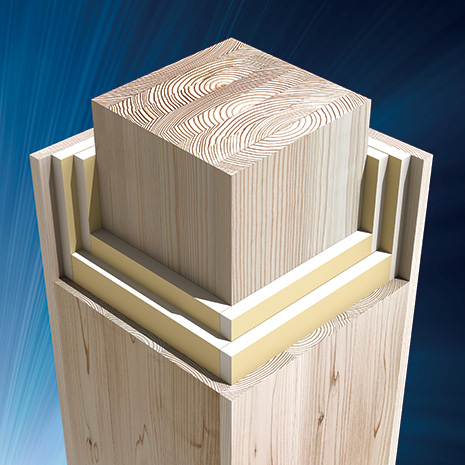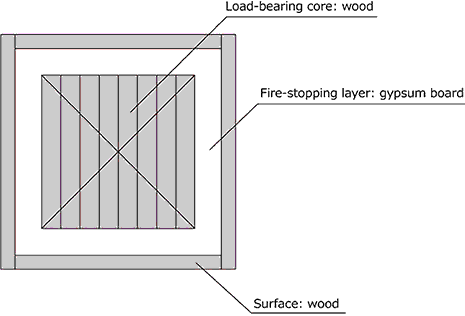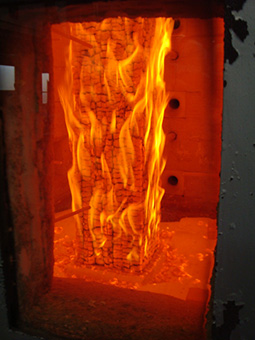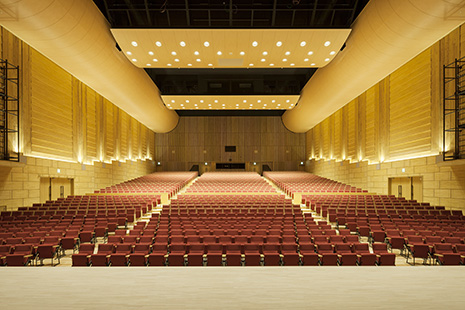VOL.192 MAY 2024
JAPAN’S HEALING FORESTS (PART 1)
[SCIENCE & TECHNOLOGY] A Wooden “Dream Material” with Outstanding Fire Resistance

Photo: Shelter Co., Ltd.
A Japanese company has developed a wooden “dream material” with outstanding fire resistance that can be processed in the same way as ordinary wood and maintains the warmth of its appearance. This new fireproof wooden material features a three-layer construction with gypsum board inserted in between layers of wood. It can even be used to construct large high-rise buildings, which until now could only be built with reinforced concrete or steel frames.
In Japan, a country blessed with an abundance of forest products, multi-story buildings and other large structures have been built with wood since ancient times. A classic example is the five-storied pagoda of Horyu-ji*, a Buddhist temple in Ikaruga, Nara Prefecture thought to be one of the oldest existing wooden structures in the world. The beautiful pagoda, about 30 meters in height, was built with advanced technology for its time, and has been standing tall for more than 1,300 years. Numerous structures at Horyu-ji, including this five-story pagoda, were given UNESCO World Heritage Site status in 1993 as “Buddhist Monuments in the Horyu-ji Area.”
Despite this, even in a country like Japan with a proud history of such advanced wooden construction technology, it has been difficult to overcome the major weakness of wood as a building material: its low fire resistance. Historically, both Kyoto (Heian-kyo, a former name), the capital of Japan for more than 1,000 years from the end of the 8th century, and Edo (present-day Tokyo), the political and economic center of Japan during the Edo period (from the early 17th century to the mid-late 19th century), were repeatedly struck by large fires and reduced them to ashes on several occasions. For this reason, since the beginning of modernization following the end of the Edo period, wooden structures, particularly large buildings and those with multiple stories, have been regulated by the Japanese government, primarily in the interest of fire prevention.
On the other hand, if it were only possible to create fireproof wood materials while maintaining the texture and warmth of wood, large-scale wooden buildings could be built. Until now, however, “non-flammable wood” has been the stuff of dreams.
A new construction material now offers a solution to the challenging technical problem of creating a wooden material that will not burn. COOL WOOD** was developed in 2013 by Shelter Co., Ltd., a company founded in 1974 and headquartered in Yamagata City. COOL WOOD features a three-layer structure that consists of a load-bearing wooden core, a fire-stopping gypsum board, and a surface layer made with wood. (See photo.) The core and surface layers can also be made with cedar or cypress and others, both local specialty woods.

Photo: Shelter Co., Ltd.
COOL WOOD has also passed a stringent fire resistance test prescribed by the Japanese government (Ministry of Land, Infrastructure, Transport and Tourism). In the most stringent three-hour fire resistance performance test, the test specimen was exposed to fire at temperatures exceeding 1,000°C for three hours, then left in the furnace with the fire extinguished for nine more hours. After these 12 hours, the furnace was opened and inspected to see if any burn marks would be found on its load-bearing wooden core. This was to confirm that, in the event of a fire, even if it were not possible to extinguish it for an extended period of time, the fire would die out spontaneously and the building would not collapse.

Photo: Shelter Co., Ltd.
COOL WOOD was patented in 2009 and passed the three-hour fire resistance test in 2017. It has attracted attention in Western countries, where there is strong concern regarding environmental issues. The material has been patented in Canada and Switzerland as well, and technical cooperation involving it has taken place in Switzerland and the US. In 2020, Shelter Co., Ltd. received the Award for Science and Technology (Technology Category) by the Minister of Education, Culture, Sports, Science and Technology for its development of this fireproof wooden material.
At the present time, the number of large buildings employing COOL WOOD, taking advantage of the texture and warmth of wood, is increasing throughout Japan. These include the largest wooden concert hall*** in the world, which is located in Nanyo City, Yamagata Prefecture; a commercial facility directly connected to a railway station in Odawara City, Kanagawa Prefecture; and a 10-story office building in the Nihonbashi Kabuto-cho district of Chuo City in Tokyo. COOL WOOD is also used for the pillars and beams of the wooden part of the Toyosu Senkyaku Banrai facilities in Tokyo’s Koto City, a market combining eateries and retail shops with an atmosphere recreating an Edo-period townscape.

Photo: Shelter Co., Ltd.
An increase in demand for wood could have a stimulating effect on Japan’s forestry industry, which is currently in decline, while also increasing carbon dioxide absorption as abandoned forests are replanted and cared for. Promoting local production and local consumption of lumber could also help revitalize local communities. The diverse possibilities offered by this wooden “dream material” with its outstanding fire resistance continue to expand.
* Considered to have been built by Prince Shotoku (574–622) in the early 7th century. Destroyed by a fire in 670, it was later rebuilt in its current form.
** Registered trademark of Shelter Co., Ltd.
*** Recognized by Guinness World Records™ on December 21, 2015 as the largest wooden concert hall in the world.
By Fukuda Mitsuhiro
Photo: Shelter Co., Ltd.

